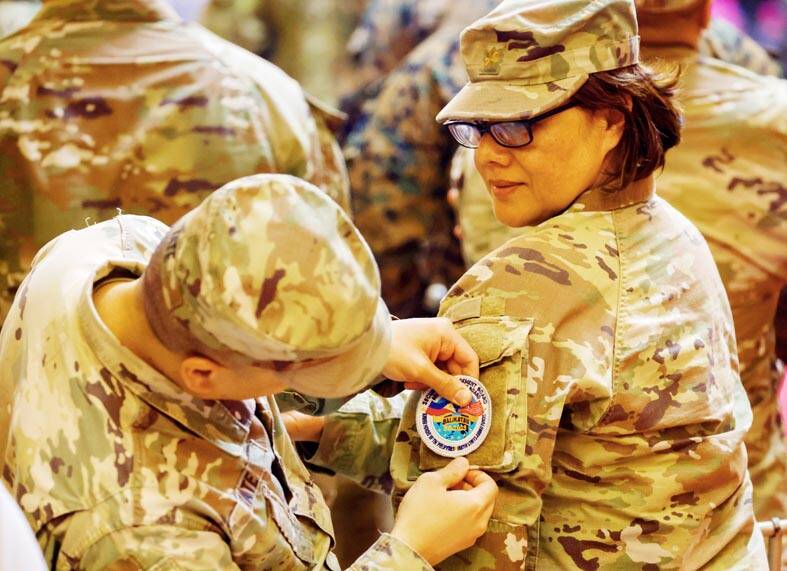US and Philippine forces yesterday launched their largest combat exercises in decades in the Philippines and its waters across the South China Sea and the Taiwan Strait, where Washington has repeatedly warned China over its increasingly aggressive actions.
The annual drills by the allies called Balikatan — Tagalog for “shoulder-to-shoulder” — are to run until April 28 and involve more than 17,600 military personnel.
“The relationships that we have, that we build into these exercises, will make us faster to respond to conflict, crisis, humanitarian assistance and disaster relief,” US Marine Major General Eric Austin said.

Photo: EPA-EFE
About 12,200 US military personnel, 5,400 from the Philippines and 111 Australians are taking part in the exercises, the largest since Balikatan started three decades ago.
The drills are to showcase US warships and fighter jets, as well as Patriot missiles, HIMARS and anti-tank Javelins, US and Philippine military officials said.
In a live-fire drill, US and Philippine forces would sink a target ship in the Philippine territorial waters off the western province of Zambales on April 26, in a coordinated inland and coastal artillery bombardment and airstrike, Colonel Michael Logico, a Philippine spokesman for Balikatan, told reporters.

Photo: AFP
“We have to fire at a target that is closer to what we would expect in an actual threat, which is an intrusion coming from an adversary by sea,” Logico told reporters. “We are demonstrating that we are combat ready.”
Asked if Philippine President Ferdinand Marcos Jr raised any concern that Beijing might be antagonized by the rocket-firing near the waterway, Logico said that did not come up when he briefed the president about the event.
Marcos wants to witness the live-fire drill, he said.
In western Palawan province, which faces the South China Sea, the exercises would involve retaking an island captured by enemy forces, Logico said.
Philippine military officials said that the maneuvers were aimed at bolstering the country’s coastal defense and disaster-response capabilities, and were not aimed at any country.
China last week warned against the intensifying US military deployment to the region.
Chinese Ministry of Foreign Affairs spokeswoman Mao Ning (毛寧) said in a regular news briefing in Beijing that it “would only lead to more tensions and less peace and stability in the region.”

The CIA has a message for Chinese government officials worried about their place in Chinese President Xi Jinping’s (習近平) government: Come work with us. The agency released two Mandarin-language videos on social media on Thursday inviting disgruntled officials to contact the CIA. The recruitment videos posted on YouTube and X racked up more than 5 million views combined in their first day. The outreach comes as CIA Director John Ratcliffe has vowed to boost the agency’s use of intelligence from human sources and its focus on China, which has recently targeted US officials with its own espionage operations. The videos are “aimed at

STEADFAST FRIEND: The bills encourage increased Taiwan-US engagement and address China’s distortion of UN Resolution 2758 to isolate Taiwan internationally The Presidential Office yesterday thanked the US House of Representatives for unanimously passing two Taiwan-related bills highlighting its solid support for Taiwan’s democracy and global participation, and for deepening bilateral relations. One of the bills, the Taiwan Assurance Implementation Act, requires the US Department of State to periodically review its guidelines for engagement with Taiwan, and report to the US Congress on the guidelines and plans to lift self-imposed limitations on US-Taiwan engagement. The other bill is the Taiwan International Solidarity Act, which clarifies that UN Resolution 2758 does not address the issue of the representation of Taiwan or its people in

US Indo-Pacific Commander Admiral Samuel Paparo on Friday expressed concern over the rate at which China is diversifying its military exercises, the Financial Times (FT) reported on Saturday. “The rates of change on the depth and breadth of their exercises is the one non-linear effect that I’ve seen in the last year that wakes me up at night or keeps me up at night,” Paparo was quoted by FT as saying while attending the annual Sedona Forum at the McCain Institute in Arizona. Paparo also expressed concern over the speed with which China was expanding its military. While the US

SHIFT: Taiwan’s better-than-expected first-quarter GDP and signs of weakness in the US have driven global capital back to emerging markets, the central bank head said The central bank yesterday blamed market speculation for the steep rise in the local currency, and urged exporters and financial institutions to stay calm and stop panic sell-offs to avoid hurting their own profitability. The nation’s top monetary policymaker said that it would step in, if necessary, to maintain order and stability in the foreign exchange market. The remarks came as the NT dollar yesterday closed up NT$0.919 to NT$30.145 against the US dollar in Taipei trading, after rising as high as NT$29.59 in intraday trading. The local currency has surged 5.85 percent against the greenback over the past two sessions, central